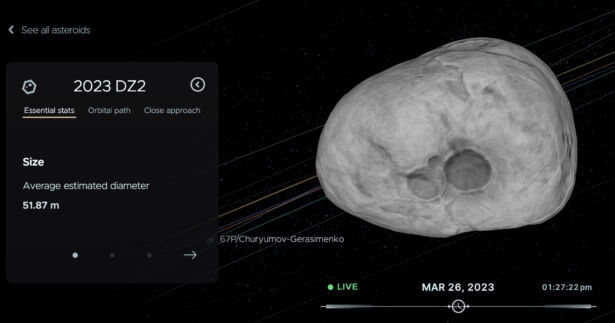An asteroid, large enough to wipe out an entire city, passed between Earth and the Moon on March 25. The European Space Agency (ESA) announced that it will use the once-in-a-decade event as a training exercise for planetary defense.
The asteroid, which according to the ESA measures between 130 and 230 feet, was named 2023 DZ2. It posed no threat and zoomed at a safe distance from Earth.
“At 19:49 GMT on Saturday (March 25) it will come within a third of the distance from the Earth to the Moon. Though that is “very close,” there is nothing to worry about, Richard Moissl, head of the ESA’s planetary defense office told French News agency AFP.
“Small asteroids fly past every day, but one of this size coming so close to Earth only happens around once every 10 years,” Moissl explained.

A rare occurrence, the asteroid passed Earth at a speed of just over 17,000 miles per hour. Its distance from Earth was almost 110,000 miles while it was roughly 240,000 miles away from the moon. It was first spotted in late February from an observatory in La Palma, one of the Spanish Canary islands.
According to Moissl, the UN-endorsed International Asteroid Warning Network earlier announced that it would use the opportunity to study the asteroid and carry out a “rapid characterization,” meaning the asteroid will be analyzed by astronomers around the globe using a range of instruments, such as spectrometers and radars.
Their aim, Moissl went on to say, is to establish how much information can be obtained about the asteroid in a short space of time, as well as prepare the scientists for a possible future threat by other space satellites.
“It will also serve as training for how the network “would react to a threat” possibly heading our way in the future,” Moissl stated.
According to Moissl, preliminary data identifies 023 DZ2 as an object of scientific interest. This may indicate that the asteroid could be unusual in its composition, however, more data was needed to get a clearer picture.
The asteroid will pass by Earth again in 2026. While it was initially believed to pose a threat at that time, scientists later determined that there would be no threat of impact for at least the next 100 years.
An asteroid of similar size, named 2023 DW, was reportedly deemed a one-in-432 chance of impacting Earth on Valentine’s Day 2046, earlier this month.
Further calculations, however, eliminated any chance of an impact, a typical conclusion with newly discovered asteroids.
According to Moissl, 2023 DW is now expected to miss Earth by some 4.3 million kilometers, as reported by Phys.org.
The good news is that in the event of a likely future impact with Earth, our planet is no longer defenseless.
In 2022, a NASA spacecraft known as DART (Double Asteroid Redirection Test), was scrambled to purposely collide with Dimorphos, a pyramid-sized asteroid. DART managed to veer the object off its course significantly in the first test of this kind.
Before impact, it took Dimorphos just under 12 hours to complete an orbit of its larger parent asteroid, Didymos, the BBC reported.

